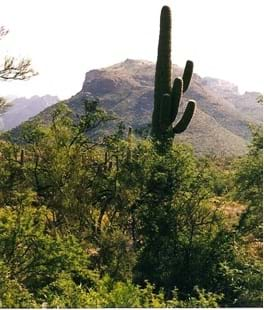
Summary
Students are presented with an engineering challenge: To design a sustainable guest village within the Saguaro National Park in Arizona. Through four lessons and five associated activities, they study ecological relationships with an emphasis on the Sonoran Desert. They examine species adaptations. They come to appreciate the complexity and balance that supports the exchange of energy and matter within food webs. Then students apply what they have learned about these natural relationships to the study of biomimicry and sustainable design. They study the flight patterns of birds and relate their functional design to aeronautical engineering. A computer simulation model is also incorporated into this unit and students use this program to examine perturbations within a simple ecosystem. The solution rests within the lessons and applications of this unit.Engineering Connection
The study of ecological processes that stress the strategies of energy conservation along with recycling of resources in the absence of waste and pollution are time-tested models for industry and urban design. They provide examples of sustainable design and biomimicry. The engineering fields of civil, aeronautical, manufacturing, automotive, electrical and architectural have benefited from the ingenuity observed within ecosystems.
Unit Overview
This four-lesson "legacy cycle" unit for science and technology classes is structured with a contextually-based Grand Challenge followed by a sequence of instruction in which students first offer initial predictions (Generate Ideas) and then gather information from multiple sources (Multiple Perspectives). This is followed by Research and Revise as students integrate and extend their knowledge through a variety of learning activities. The cycle concludes with formative (Test Your Mettle) and summative (Go Public) assessments that lead students towards answering the Challenge question. See below for the progression of the legacy cycle through the unit. Research and ideas behind this way of learning may be found in How People Learn, (Bransford, Brown & Cocking, National Academy Press, 2000); see the entire text at https://www.nap.edu/read/9853/chapter/1
The "legacy cycle" is similar to the "engineering design process" in that they both involve identifying an existing societal need, combining science and math to develop solutions, and using the research conclusions to design a clear, conceived solution to the original challenge. Though the engineering design process and the legacy cycle depend on correct and accurate solutions, each focuses particularly on how the solution is devised and presented. See an overview of the engineering design process at https://www.teachengineering.org/populartopics/designprocess
Educational Standards
Each TeachEngineering lesson or activity is correlated to one or more K-12 science,
technology, engineering or math (STEM) educational standards.
All 100,000+ K-12 STEM standards covered in TeachEngineering are collected, maintained and packaged by the Achievement Standards Network (ASN),
a project of D2L (www.achievementstandards.org).
In the ASN, standards are hierarchically structured: first by source; e.g., by state; within source by type; e.g., science or mathematics;
within type by subtype, then by grade, etc.
Each TeachEngineering lesson or activity is correlated to one or more K-12 science, technology, engineering or math (STEM) educational standards.
All 100,000+ K-12 STEM standards covered in TeachEngineering are collected, maintained and packaged by the Achievement Standards Network (ASN), a project of D2L (www.achievementstandards.org).
In the ASN, standards are hierarchically structured: first by source; e.g., by state; within source by type; e.g., science or mathematics; within type by subtype, then by grade, etc.
See individual lessons and activities for standards alignment.
Subscribe
Get the inside scoop on all things TeachEngineering such as new site features, curriculum updates, video releases, and more by signing up for our newsletter!Unit Schedule
- Day 1: Designing a Sustainable Guest Village in Saguaro National Park lesson
- Day 2: Designing a Winning Guest Village in Saguaro National Park activity (Note: 45 minutes to introduce the activity; then several weeks for teams to prepare presentations; see the Procedure section for details)
- Day 3-4: Food Chains and Food Webs - Balance within Natural Systems lesson
- Day 5: Constructing Sonoran Desert Food Chains and Food Webs activity
- Day 6-9: Biomes and Population Dynamics - Balance within Natural Systems lesson
- Day 10-11: Computer Simulation of the Sonoran Desert Community activity
- Day 12-14: Biomimicry and Sustainable Design: Nature as Engineering Marvel lesson
- Day 15-16: Bird Flight Adaptations: Inspiration for Aeronautical Engineering activity
- Day 17: Bees: The Invaluable Master Pollinators activity
More Curriculum Like This

Students are challenged to design a permanent guest village within the Saguaro National Park in Arizona. To successfully address and respond to this challenge, students must acquire an understanding of desert ecology, environmental limiting factors, species adaptations and resource utilization.

Students are introduced to the concepts of biomimicry and sustainable design. As students focus on applying the ecological principles of the previous lessons to the future design of our human-centered world, they also learn that often our practices are incapable of replicating the precision in which...

Students are presented with an engineering challenge that asks them to develop a material and model that can be used to test the properties of aortic valves without using real specimens. Developing material that is similar to human heart valves makes testing easier for biomedical engineers because t...

Students explore the structure and function of cell membranes. As they study the ingress and egress of particles through membranes, students learn about quantum dots and biotechnology through the concept of intracellular engineering.
Copyright
© 2013 by Regents of the University of Colorado; original © 2006 Vanderbilt UniversityContributors
Wendy H. Holmgren; Megan Johnston; Amber SpolarichSupporting Program
VU Bioengineering RET Program, School of Engineering, Vanderbilt UniversityAcknowledgements
The contents of this digital library curriculum were developed under National Science Foundation RET grant nos. 0338092 and 0742871. However, these contents do not necessarily represent the policies of the NSF, and you should not assume endorsement by the federal government.
Last modified: February 13, 2024







User Comments & Tips